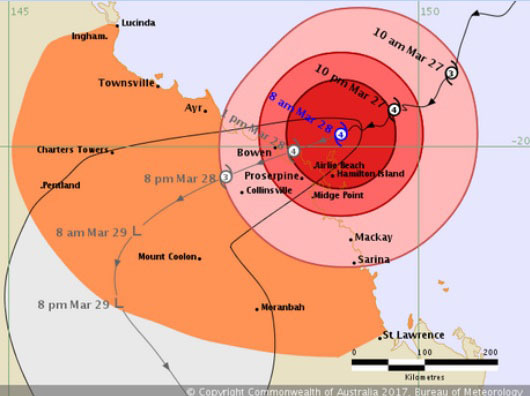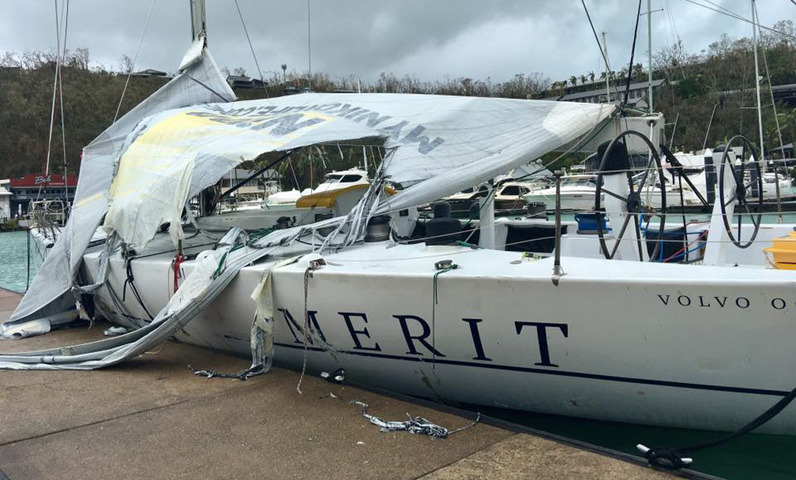
April Latitude on the Docks Today

The March of time. It’s not quite April, yet we’re launching the April issue of Latitude 38 today, March 31st. With a classic Jim DeWitt painting as its cover art, the issue celebrates our reaching 40 years of publishing, which we think is a pretty big deal.
As you read this, our delivery trucks are ‘enjoying’ Bay Area traffic, so you can pick up our latest launching at your favorite marine outfitter, yacht club, marina or other marine location. If for no other reason, pick one up so you can redecorate your coffee table or nightstand, or refresh the reading material in your head. (The free digital version will be available to read online or download by mid-afternoon today.)
Inside this month’s issue you’ll find our usual mix of sailing news from around the Bay Area and around the world. This month’s features include the first installment of a multi-part retrospective on highlights of Latitude‘s past reporting, our recap of the Richmond Yacht Club’s Small Boat Midwinters, mini-profiles of Pacific Puddle Jumpers, an America’s Cup 35 primer, and Max Ebb — who looks at marine technologies now vs back in ’77, when Latitude‘s issue #1 was published.

©2017Latitude 38 Media, LLC
The April Latitude’s release today is just in time for your weekend and for the launching of the brigantine Matthew Turner in Sausalito, tomorrow at 4 p.m. We launch a new Latitude each month, but you may have to wait another 100 years or so for the next launching of a 100-ft, hand-built, wooden tall ship in the Bay Area.
Cat. 4 Cyclone Smashes Aussie Coast
Boat owners and residents in Australia’s northeast are cleaning up and assessing the damage after Tropical Cyclone Debbie hit the region Tuesday morning. The storm — which reached category 4 strength — is said to be the largest to hit Australia since Cyclone Tracy destroyed Darwin in 1974.
Debbie smashed its way through the Whitsunday Islands, Queensland’s famous sailing and tourist destination, with winds exceeding 140 miles per hour, carving a trail of chaos and destruction on Hamilton Island and the mainland towns of Airlie Beach, Shute Harbor and Proserpine. Boaters from the famed sailing destination — which may be familiar to Pacific Puddle Jumpers — are now facing the daunting task of salvaging vessels from damaged marinas and harbors.

Debbie has now been downgraded to a severe tropical storm. Emergency and relief efforts are spread thin, as Queensland continues to be threatened by flooding. There are widespread power outages, and water supplies are scarce. Schools and businesses throughout southeast Queensland and northern New South Wales remain closed as the storm continues to crawl south.
Cyclone Debbie made landfall early Tuesday morning. Despite being downgraded to a category three storm when it hit the coast, Debbie took an excruciatingly slow path before turning southward. People hunkering down in shelters were granted a small reprieve around midday, as the eye of the storm passed near Airlie Beach. But the storm continued on with tidal surges and cyclonic winds that ravaged buildings, docks and boats.
Those who live and sail in the Whitsundays are familiar with severe storms and cyclones, but many locals said Debbie was the worst storm they’d ever seen. Sailboats were sunk, flipped, smashed into breakwalls, beached on shore and had their masts, rigging and cabin-tops torn apart.

Professional Boat Care, a Brisbane-based company, said they always warn clients about the dangers of sailing north during cyclone season. Owner Peter Jenyns has been taking and sharing photos to assist absentee owners in identifying their vessels.
"I understand the marina workers are dealing with an overwhelming situation and have no communication facilities as of yet," said Jenyns.
"We’ve been overwhelmed with thankful owners who have now been able to identify their boats and the damage sustained through our photos," Jenyns added. "Sadly, just as many are asking if we can help find their missing boats."
What Would You Have Done?
Just before posting today we were alerted to the stunning video below. It is a classic example of being in the wrong place at the wrong time — something many longtime sailors can relate to.
All we know about the incident is that the sloop (name yet unknown) somehow got inside the surf line yesterday evening off Redondo Beach’s King Harbor Pier, and its crew were unable to work back out to sea.
Video courtesy Kakek Tube
According to Holly Scott’s Facebook post, where we first saw it, first responders from the L.A. County Fire Department, Lifeguard Division were called to the scene around 7 p.m., and four people were rescued. We certainly hope none were seriously injured.
There are always ‘lessons learned’ from such mishaps. So tell us, what would you have done if you found yourself slipping dangerously close to shore — or pier pilings — with no easy exit? Write us here.
Tere’s Tips on Temporary Import Permits
For most of the history of the Mexican Marina Owners Association, Tere Grossman, whose family has several marinas in Mexico, has been president of the association. Over the years she has spent a tremendous amount of time — and no doubt money — helping foreign boatowners who have had TIP (Temporary Import Permit) and other problems. So we suggest you pay attention to what she has to say about TIPs.
“I am enclosing the following circular that I have sent to all our marina clients so that they don’t get into trouble with the Mexican authorities because they lacked important information about TIPs.
“As all foreign boatowners know, in order to legally have a boat in Mexico, you have to obtain a Temporary Import Permit (TIP) before you arrive. You can get them online before you go to Mexico. This TIP is valid for 10 years and only costs $50. It’s a real bargain, as it’s more than the yearly registration for the boat in the States.
“However, there are serious consequences if you: 1) Let the TIP expire while the boat is still in Mexico. It has to be renewed BEFORE it expires. And 2) If you sell or buy a boat in Mexico.
“When a Mexican tourist goes to the United States, he/she has to get a permit that allows him/her to be in the States the amount of time that they ask for. The maximum is six months. But if he/she gets caught with that permit expired, he/she can be deported or even imprisoned. So the Mexican tourist has to be very aware of the expiration date of their visa.
“It’s the same thing in Mexico with your boat’s TIP. At our marina, we try to remind everyone when their TIP is about to expire so that it can be renewed before it expires. Some clients don’t take it seriously, and thus don’t do anything.
“Recently a client of ours not only let the TIP expire, but with it already expired, he went to the Customs office to renew it. It was as if a Mexican tourist in the United States went to the police to let them know that their visa has expired, and thus they were in the country illegally. Not good.
“If you buy or sell a boat in Mexico that has a TIP, even if the TIP is current, you could lose the boat. That’s because buying or selling a boat with a TIP in Mexico is illegal, because it’s on a TIP, and TIPs can’t be transferred.
“I know of cases where a boat owner has gone to the authorities and told them that he/she just bought a boat in Mexico and wants the TIP transferred to their name. What that person is doing is telling the authorities that they just illegally bought a boat in Mexico. The boat is thus considered contraband and is subject to confiscation. It may not be confiscated, but it could be.
“So please, please, please, if your TIP expires, don’t go to the authorities, come to the marina office so we can help you solve the problem and give you the options that you have.” — Signed Tere Grossman
We can’t echo Tere’s advice strongly enough. TIPs are ridiculously inexpensive and they are easy to get. Get one! And don’t let it expire without getting a new one.
If you do have a problem with a boat in one of her marinas, contact her. If you have a boat with a TIP problem that is not in her marina, we suggest that you confer with Victor Barreda of Agencia Barreda in Cabo San Lucas. Victor, and his father before him, have been handling boat paperwork and paperwork problems in Cabo since 1975, when it wasn’t much more than a two-burro town. He can be reached by email.
More than half of the Baja Ha-Ha boatowners use Victor’s services to check into Mexico each year. If you’ve got a paperwork question, he’s a great guy to ask. Tell him the Grand Poobah sent you.
As for the legality of buying and selling a boat in Mexico, we suspect that Tere Grossman is correct that it’s technically illegal. That said, we know of many people who have bought and sold boats in Mexico without a problem. We’re not sure how they have done this, just that they have. The law in Mexico can sometimes be very flexible. For example, all boats are supposed to have a TIP — get yours online — before arriving in Mexican waters. But for as long as we can remember, there hasn’t been a problem with boatowners who didn’t get a TIP until their first chance in Mexico, which would be Ensenada or La Paz — but not Cabo because it doesn’t have a Banjercito. Nonetheless, you want to know what the law is.
When at all possible, comply with all Mexican laws, even if they are often flexible. Officials are given a lot of discretion in how to enforce the law, and what some officials will allow, others won’t.
By and large Mexico makes it very easy to comply with their rules. Don’t foolishly give them the opportunity to make life miserable for you.
